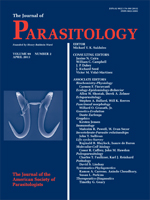The tick Ixodes brunneus Koch is a rare species occurring primarily in North America, where it feeds on many species of passeriform birds. Virtually nothing is known about the questing activity of this tick, although adults often stand with their front legs straight up, suggesting that they quest from a horizontal position. The present study analyzed I. brunneus questing behavior based on field data from drag cloth collections in northern Mississippi, as well as observational laboratory data from 10 I. brunneus ticks released into an experimental “questing apparatus.” Ten ticks of a related species, I. scapularis Say, were used for comparison, and there were 3 replications each trial. Eight I. brunneus adults were collected along a nature trail in a northern Mississippi park during 20 total swaths with a drag cloth over a 2-day period (each time 5 swaths in the middle of the trail, with little or no vegetation; and 5 swaths along the edge of the trail, with taller vegetation). All 8 ticks were collected in the middle of the trail in vegetation no taller than 40 mm. In the laboratory experiment, the majority (>70%) of ticks of both species made no attempt to climb the metal or wood artificial stems, but instead they crawled around on the substratum. In 8/30 instances, I. brunneus climbed metal artificial stems to various heights as opposed to 4/30 instances for I. scapularis. Sometimes, ticks of both species seemed to quest at the base of both types of artificial stems. The mean height for questing by I. scapularis on metal stems was 38.2 mm as opposed to 31.8 mm for I. brunneus. Although the mean height was slightly higher for I. scapularis compared with I. brunneus, there was no statistical difference in questing heights observed between the 2 species. Ixodes brunneus and I. scapularis climbed wooden artificial stems in only 2/30 instances for each tick species, again with no statistical difference in questing heights between species. The field observations suggest that I. brunneus quests at ground level; however, laboratory simulations revealed that although the average height climbed was below 40 mm, they sometimes climb artificial stems to greater heights (approximately 50 mm in 4 instances).
How to translate text using browser tools
1 April 2013
Observations on Questing Activity of Adult Ixodes brunneus Koch (Acari: Ixodidae) in Mississippi
Jerome Goddard
ACCESS THE FULL ARTICLE

Journal of Parasitology
Vol. 99 • No. 2
April 2013
Vol. 99 • No. 2
April 2013




